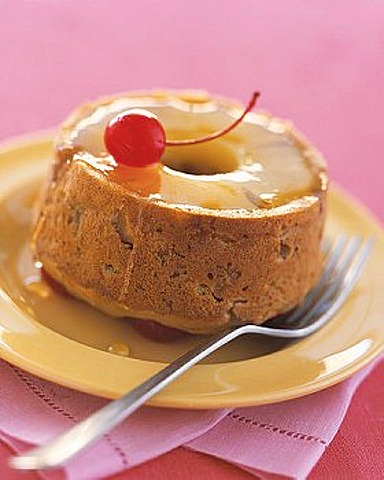
Stock photo
Pineapple Upside-Dow Cake is an American classic dessert. The idea of cooking a fruit cake upside down, started centuries ago when cakes were cooked in cast iron skillets. Fruit and sugar were added in the bottom of the pan and a simple cake batter was placed on top and put it over the fire to cook.
Then the cake was flipped over onto a plate to show the pretty caramelized fruit and let the sugary juices run down the sides. The idea of the pineapple soon after 1911 when one of James Dole's engineer had invented a machine to cut his pineapples into nice rings.
CAKE RECIPE HELP
INGREDIENTS
Topping:
3 to 4 tablespoons unsalted butter
1/3 to 1/2 cup dark brown sugar, packed
9 pineapple canned rings (1, 20-ounce can), well drained on paper-towels; reserve 1/2 cup juice
9 maraschino or canned Bing cherries, pitted
Pecan halves, lightly toasted
Cake:
1 1/2 cups sifted cake flour; sift cake flour and then spoon into measuring cup and level to rim
2 1/2 teaspoons baking powder
1/4 teaspoon salt
1/3 cup (5 tablespoons plus 1 teaspoon) unsalted butter, cold
1/2 cup sugar
2 large eggs
1 teaspoon vanilla
1/2 cup reserved pineapple juice or orange juice
INSTRUCTIONS
1. Position rack in the lower third of the oven and preheat to 350 degrees F.
Topping
1. Coat 9 x 9 x 2-inch square pan with 3 to 4 tablespoons melted butter. Sprinkle brown sugar over the butter and press it evenly across its surface. Arrange the pineapple slices, 3 to a row, making 3 rows. Place a cherry in the center of each ring. Fill in the empty spaces in between the pineapple rings with pecans halves, rounded side down. Set aside.
Cake
1. Sift together the flour, baking powder, and salt into a medium size bowl. Set aside.
2. Cut the butter into 1-inch size pieces and with a stand mixer fitted with a paddle attachment, soften on low speed. Increase mixer speed to to medium and beat until light and creamy, about 1 minute. Slowly at the side of the bowl, add the sugar and beat the two together until light and fluffy, about 2 to 3 minutes.
3. With the mixer on low, add the eggs one at a time and beat for 20 seconds after each addition. After the eggs have been added, increase the mixer speed to medium and beat the mixture for 1 minute. (If the eggs are cold, the batter will curdle slightly. It's ok. It will come together as the batter warms from the beaters.)
4. With the mixer on low, add the flour mixture in 3 equal portions, alternating with the juice in 2 equal portions, beginning and ending with the flour. (If the juice is cold, the batter will curdle slightly. It's ok. It will come together when you add the flour.)
Add the flour and liquid ingredients in increments quickly; do not wait in between additions too long as you don't want to overmix the batter.
After completing the last addition of flour, stop the mixer, and scrape the side and bottom of the bowl with a large rubber spatula. Then, let the mixer run for 30 seconds on LOW. STOP the mixer. Do NOT overmix.
5. Remove the mixing bowl from the mixer. With a large rubber spatula, give the batter ONE or TWO quick folds to incorporate any stray flour or milk left at the sides and bottom of the bowl. Then, STOP!
Scoop the batter into the prepared pan, spreading it from the sides to the center. Gently smooth the top.
6. Bake the cake for 30 to 35 minutes or until the edges of the cake are brown and the juices around the sides of the pan begin to bubble.
7. Remove from the oven and let cool on a wire cake rack for 5 to 10 minutes. Run a thin knife around the edge of the pan to loosen the cake.
8. Place a serving platter with rims on top of the pan and holding both, invert.
Let stand for 5 minutes before removing the pan. If any fruit remains in the pan, carefully arrange back on the cake.
NOTE: If you don't want to serve it right away, don't invert. Let the cake cool in the pan. When you are ready to serve, warm the cake for about 15 minutes in the oven at 350 degrees F, let sit for 5 minutes and then invert.
SERVE
Slice into squares and top with a dollop of freshly whipped cream. The cake is best served warm.
STORAGE
Cover cake loosely with aluminum foil. Cover with plastic wrap and refrigerate for up to three to four more days. Cake can be frozen in its pan for up to a month.


